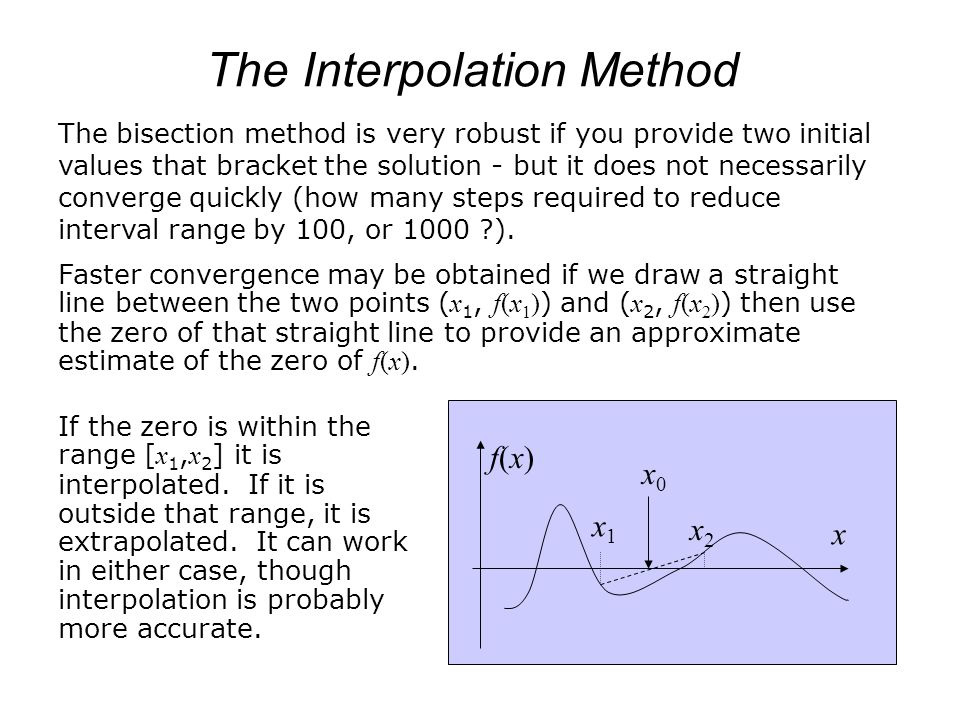Program For Bisection Method In Fortran Compilers

Mar 9, 2018 - Program bisection implicit none real:: a,b,c,error,f error = 1.0e-06 write( *, *) 'Enter two numbers a and b simultaneously between which the root.
I have a text file containing comma-separated numbers like so: 77, 78, 71, 75, 78, 7 It is not known how many of these numbers are present in this file; it varies but is limited to a few hundred numbers. The objective is to: • Open this file (say, customwav.txt) and find out how many numbers are present in this file --> U 34 37 v opisanie mestnosti po topograficheskoj karte 2. put them into an integer n. • Allocate memory for these numbers into an array --> I already have subroutines that do this for me. • Read the line of numbers into this allocated array. What is the best way to do 1 and 3 in Fortran?
You need to give limits for some assumptions, say: is there a limit to the length of a line. If there is and there are multiple lines, then do a first pass counting the number of lines, number of commas in each line and max commas in a line.(num_commas + num_lines = num_values). Then rewind, allocate arrays and read the data. Alternatively, you know the file size so make a conservative guess. Given available memory, you can typically have a rough idea of what is required; A million lines and 10 million values covers a lot of possibilities, which is very little if you have 8gb memory.
– Jul 19 '18 at 1:24. My approach for an unknown file is to first open it using stream I/O, read 1 character at a time and count the occurrence of all characters in the file: count_characters(0:255). This can tell you a lot about what to expect, such as: LF indicates number of lines in file CR indicates DOS file rather than unix file format. Can indicate real numbers, can indicate csv file format; /: can indicate other delimiters presence of non-numeric characters indicates non-numeric information E or e can indicate scientific format / or: can indicate date/time info The count_ + count_, is an estimate of numbers in the file. The advantage of this approach is that it identifies possible unusual data to be recovered. It is probably best as a stand alone utility, as the interpretation can be difficult to code.

OP tells us the file contains a few hundred real numbers, neatly separated by commas. Here's a simple approach to reading those into an array of the right size. This is indifferent to the number of lines in the file.
First, declare an allocatable array, and an integer for handling the end of file which will occur later real, dimension(:), allocatable:: numbers integer:: ios. Allocate the array, with some overhead. Yes, I'm just going to read however many numbers are in the file in one gulp, I'm not going to try to figure out how many there are.
Set every value to a guard value whose utility will be obvious later; this does assume that the file won't contain the chosen guard value numbers = -huge(1.0). Read the numbers; I assume the file is already open on unit inunit read(inunit,*,iostat=ios) numbers. At this point ios has a non-zero value but for the simple case outlined in the question there's no need to do anything with it, we've been told that there are only a few hundred of them. And finally numbers = pack(numbers, numbers>-huge(1.0)) to reallocate numbers to the right size.
Two mix mp3. The problem with this approach is assuming the values in numbers, as both at the error and beyond they are processor dependent. I have different Fortran compilers which return a different result. For 'read (line,*,iostat=iostat) (aa(i),i=1,k)' one compiler FTN95 returns I= value where error occurred (which is helpful), while another gFortran returns I=k+1 (which is not). GFortran also returns the value 0 where the error occurs, but FTN95 does not define this value. It is a problem that the error response is not defined.
- пятница 12 апреля
- 79